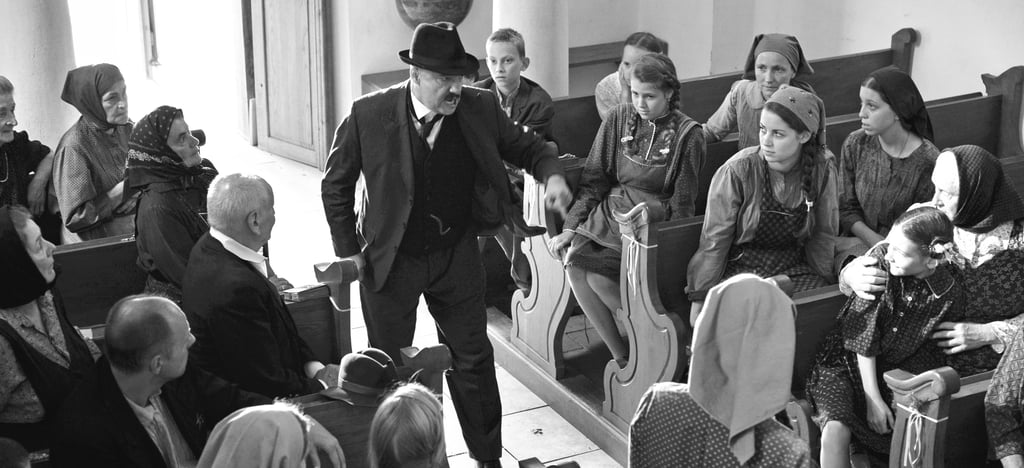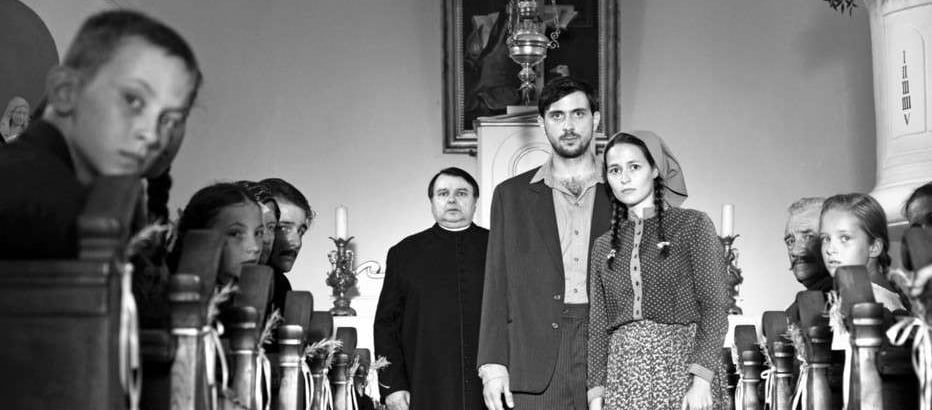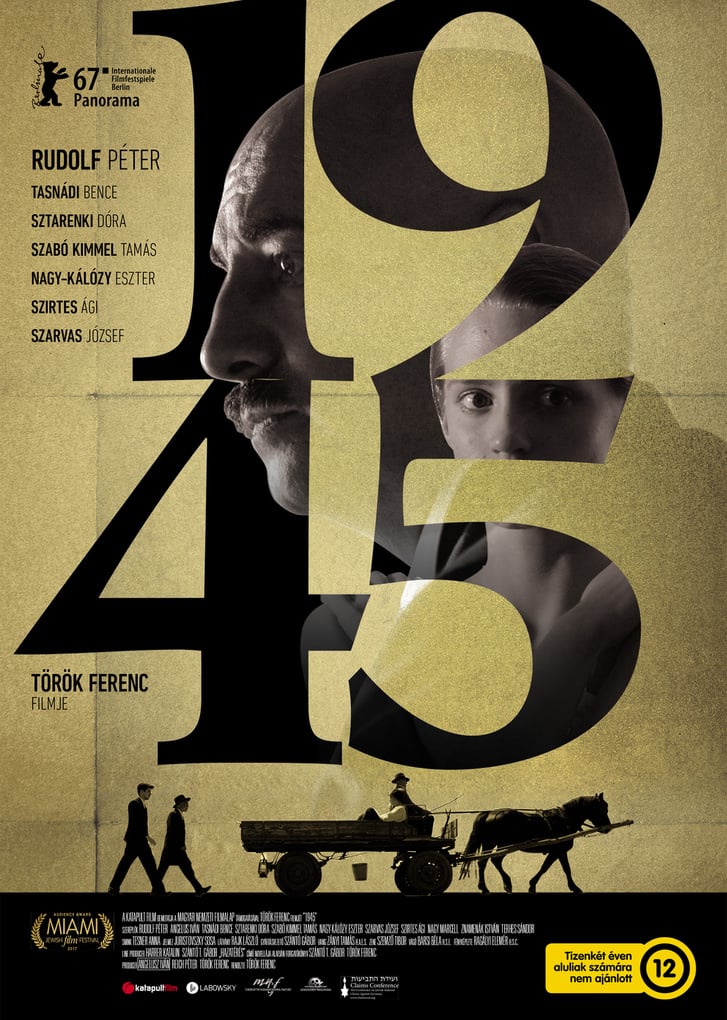1945
A taut, tension-laden work of moral reckoning that quietly unearths Hungary’s hidden past in a single small town.
A Vanishing Train, A Blighted Village, and Unspoken History
1945 opens in a small Hungarian village days after World War II’s end, where villagers gather at the tracks to witness a returning freight train—unremarkable in form but portentous in meaning. From its handbrake release to the shuffling arrival of two Jewish men in somber suits, the sequence unfolds in long, silent takes that communicate weight beyond dialogue. The film’s power lies in atmospheric restraint: villagers watch not only returning strangers but the possibility that hidden crimes, buried alliances, and communal complicity might be revealed. Director Ferenc Török builds uncanny suspense through subtle gestures—a tired shovel, exchanging glances, the careful rearrangement of orchard brooms—not action set pieces. It becomes a meditation on collective guilt, small-town denial, and the fragile balance between confession and self-preservation. As secrets loom, villagers must choose what to hide and what to surrender. This opening volley of cinematic minimalism gradually peels away the social veneer that kept complicity in place, opening the viewer to the idea that history lives not just in monuments, but in quiet silence and suppressed appearances.
And Friendship, Humanity, Respect – But On the Axis of Guilt
The arrival of two mysterious men sets off a silent crisis. They ask for water, confirm the railroad track’s condition, and quietly mention filling out paperwork to reclaim property. These casual conversations signal their knowledge of villagers’ wartime actions. The villagers—teachers, grocers, priests—exchange hesitant looks as rumor spreads. These men are reminders, symbols of the erased past still awaiting justice. Mrs. Wollner, a rational but fearful educator, senses that property and respect were taken under wartime hubris; her husband’s orchard hides truths as encoded as erupting logs half-buried under his worktable. As the community teeters, Török executes scenes of moral theater: one character tries to destroy keys; another hurries to hide frozen ice cubes; the sheriff coughs in growing panic. The film’s rhythm is collective guilt embodied in daily gestures. No villain dominates; rather, moral ambiguity reigns. The Tusnadi brothers—like many families accused after the Holocaust—must confront the reality that those they thought were long gone may yet demand accountability for deeds long unspoken.
Historical Context and Subtle Allegory
1945 situates its story in the immediate Hungarian post-war purge—a little explored period when returning Jews sought to reclaim property amidst hostility and suspicion. The story reflects real incidents where villages renamed streets, denounced neighbors for theft, or appropriated real property. But Török avoids documentary exposition; instead, he uses subtext and human conflict to evoke collective tension. Every handshake becomes a negotiation; every orchard tool is a witness. The villagers crouch between fear of new political power, guilt over the past regime, and dread of being judged by their own moral code. No speech clarifies exactly what transpired, but the film trusts in emotional truth to surface. Its allegorical undercurrent implies that even post-war justice systems fell short when local complicity lay hidden. By dramatizing daily acts rather than courtroom confrontation, 1945 spotlights the deeply unspoken forms of injustice often repeated long after regimes change.
Critical Acclaim and Festival Recognition
1945 premiered at the 64th Berlin International Film Festival in 2014, where it received the Forum section’s ecological audience award and gained immediate attention for its emotional and moral clarity against minimalistic style. Critics praised it as “quietly devastating” and “literally silent yet seething with tension.” With strong Rotten Tomatoes scores and positive reviews on Metacritic, critics highlighted its courage in depicting Hungarian guilt without spectacle. Reviewers noted that while traumas like the Holocaust have been repeatedly represented, few films have addressed the return—the reckoning that follows relative denial—as powerfully. Publications such as Sight & Sound and The Hollywood Reporter lauded it as “a masterclass in moral compression.” For many viewers, the film’s final scenes—clouded orchard, phone call unanswered, final crushed wristwatch—linger longer than more conventional endings might. While it did not receive an Academy submission, it remains one of Hungary’s most resonant post-war narratives in recent periods.
Where and How to Watch
1945 is available for streaming on several European arthouse platforms and is included in Criterion Channel’s Central European Spotlight, with subtitles in English, German, French, and Hungarian. In some regions, the film is available on Kanopy or public library streaming services tied to archives. For purchase or rental, Amazon Video, Google Play, and YouTube Movies may offer digital copies in HD format. There are also limited physical releases on Blu-ray or DVD, often including director interviews and cultural context booklets. While mainstream platforms like Netflix may not currently host it, regional streaming services in Hungary, Germany, and Scandinavia frequently offer it as part of domestic cinema libraries. The film is rated PG-13 for thematic elements of war and implied violence. Substantive metadata and closed captioning are usually provided. Viewers are encouraged to seek versions with included director commentary for deeper insight into filming choices.


Visual Precision: Long Takes, Dry Cinematography, and Emotional Distance
Cinematographer Marcell Rév frames each scene with surgical control: long static shots, minimal camera movements, and careful staging layer drama within everyday spaces. A shot lingering on the orchard’s crate, a door gently creaking open, or the stiff stance of a returning train becomes an emotional pivot point. The opening prologue contains no dialogue for several minutes, allowing the frames to breathe anxiety into the viewer. Sound is equally restrained—footsteps on gravel, distant whistles across rail lines, a distant church bell toll. Each acoustic echo becomes charged with subtext. Compared to thematic heavyweights like Michael Haneke’s hidden identity examinations, 1945 finds its political and emotional impact not in dramatizing violence but in directing stillness, in finding suspense through waiting and stillness. In one extraordinary sequence, villagers line up at the train, each confession contained not in shouting but in passing water or lingering eye contact. As secrets surface, the landscape changes: the orchard looks harvested, the tracks appear empty, and the air thick with unresolved history. This is filmmaking that trusts silence as much as speech—visual restraint as moral force.
Character Studies in Guilt, Fear, and Grace
The cast portrays a tight-knit community stretched thin by fear and social pressure. The two returning men remain physically confident, distant, and calm—a sharp contrast to the villagers’ quiet anxiety. Their demeanor invokes both authority and grief, reminding viewers that trauma outlasts departure. The villagers range from the caring teacher to the faintly compassionate dancing instructor. One elderly woman trembles as she glances at the matching gloves she once lent the train arrivals; a child asks about war and death in passing innocence. The actors bring psychological authenticity without melodrama—they breathe humanity into routine gestures like handing over soup or glancing at a portrait. The film resists moral delineation: no one is heroic, but no one is entirely villainous. Instead, Török sculpts a textured moral landscape, showing how pressure accumulates through silence, how complicity is often quiet rather than overt, and how reconciliation can only begin through interpersonal honesty. Watching the gym teacher fail to clap when others celebrate, or the wife remove her wedding ring, reveals more about complicity than a courtroom testimony.






Awarded with the Highest Distinction
1945 earned the Excellence Award for its unflinching moral examination, masterful use of silence and atmosphere, and compassionate confrontation of collective memory. It transcends traditional war narratives by asking not “what happened?” but “what remained afterward?” In its quiet tension, moral austerity, and emotional authenticity, the film exemplifies cinema’s power to reckon with history—not through spectacle, but through the weight of ordinary gestures, communal unease, and the possibility of redemption.







